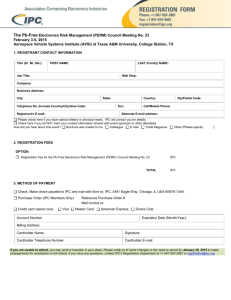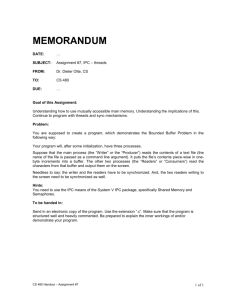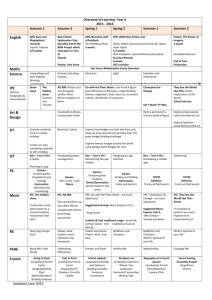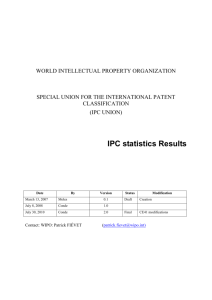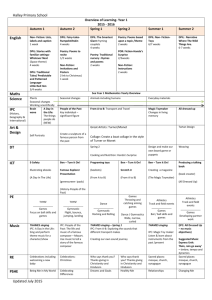RINA: An Architecture for Policy-Based Dynamic Service Management Yuefeng Wang Flavio Esposito
advertisement
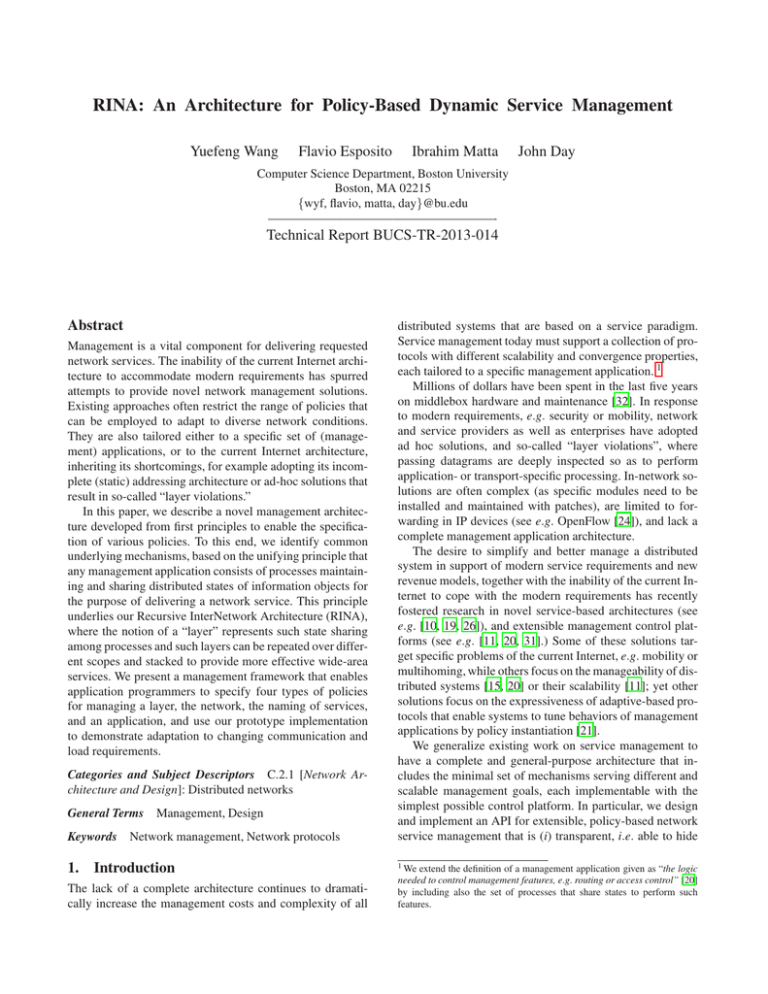
RINA: An Architecture for Policy-Based Dynamic Service Management
Yuefeng Wang
Flavio Esposito
Ibrahim Matta
John Day
Computer Science Department, Boston University
Boston, MA 02215
{wyf, flavio, matta, day}@bu.edu
——————————————————-
Technical Report BUCS-TR-2013-014
Abstract
Keywords Network management, Network protocols
distributed systems that are based on a service paradigm.
Service management today must support a collection of protocols with different scalability and convergence properties,
each tailored to a specific management application. 1
Millions of dollars have been spent in the last five years
on middlebox hardware and maintenance [32]. In response
to modern requirements, e.g. security or mobility, network
and service providers as well as enterprises have adopted
ad hoc solutions, and so-called “layer violations”, where
passing datagrams are deeply inspected so as to perform
application- or transport-specific processing. In-network solutions are often complex (as specific modules need to be
installed and maintained with patches), are limited to forwarding in IP devices (see e.g. OpenFlow [24]), and lack a
complete management application architecture.
The desire to simplify and better manage a distributed
system in support of modern service requirements and new
revenue models, together with the inability of the current Internet to cope with the modern requirements has recently
fostered research in novel service-based architectures (see
e.g. [10, 19, 26]), and extensible management control platforms (see e.g. [11, 20, 31].) Some of these solutions target specific problems of the current Internet, e.g. mobility or
multihoming, while others focus on the manageability of distributed systems [15, 20] or their scalability [11]; yet other
solutions focus on the expressiveness of adaptive-based protocols that enable systems to tune behaviors of management
applications by policy instantiation [21].
We generalize existing work on service management to
have a complete and general-purpose architecture that includes the minimal set of mechanisms serving different and
scalable management goals, each implementable with the
simplest possible control platform. In particular, we design
and implement an API for extensible, policy-based network
service management that is (i) transparent, i.e. able to hide
1. Introduction
1 We
Management is a vital component for delivering requested
network services. The inability of the current Internet architecture to accommodate modern requirements has spurred
attempts to provide novel network management solutions.
Existing approaches often restrict the range of policies that
can be employed to adapt to diverse network conditions.
They are also tailored either to a specific set of (management) applications, or to the current Internet architecture,
inheriting its shortcomings, for example adopting its incomplete (static) addressing architecture or ad-hoc solutions that
result in so-called “layer violations.”
In this paper, we describe a novel management architecture developed from first principles to enable the specification of various policies. To this end, we identify common
underlying mechanisms, based on the unifying principle that
any management application consists of processes maintaining and sharing distributed states of information objects for
the purpose of delivering a network service. This principle
underlies our Recursive InterNetwork Architecture (RINA),
where the notion of a “layer” represents such state sharing
among processes and such layers can be repeated over different scopes and stacked to provide more effective wide-area
services. We present a management framework that enables
application programmers to specify four types of policies
for managing a layer, the network, the naming of services,
and an application, and use our prototype implementation
to demonstrate adaptation to changing communication and
load requirements.
Categories and Subject Descriptors C.2.1 [Network Architecture and Design]: Distributed networks
General Terms
Management, Design
The lack of a complete architecture continues to dramatically increase the management costs and complexity of all
extend the definition of a management application given as “the logic
needed to control management features, e.g. routing or access control” [20]
by including also the set of processes that share states to perform such
features.
the implementation complexity of mechanisms, (ii) minimal
but complete, (iii) dynamic, i.e. supports policy adaptation
as network state changes, and (iv) general, i.e. usable by a
large set of management applications at different time scale
and across different scopes. The API is provided within the
framework of our Recursive InterNetworking Architecture
(RINA), whose design and implementation did not arise de
novo, but instead derives from first principles [4, 5].
RINA is based on the fundamental principle that networking is inter-process communication (IPC.) It recurses the IPC
service over different scopes. IPC processes are merely application processes that are members of a Distributed IPC
Facility (DIF.) Specifically, a scope defines a DIF comprised
of the set of IPC processes, possibly running on different
machines, that collaboratively provide a set of well-defined
flow services to upper application processes. Application
processes can themselves be IPC processes of an upper DIF
that is providing services over a wider scope.
A DIF is an organizing structure — what we generally
refer to as a “layer.” A DIF is a collection of IPC processes (nodes.) Each IPC process executes routing, transport
and management functions. IPC processes communicate and
share state information. How a DIF is managed, including
addressing, is hidden from the applications. We extend the
notion of a DIF to a Distributed Application Facility (DAF).
A DAF does not support IPC but includes management functionalities. 2
We introduce the management architecture of a DAF,
identifying four forms of management within the RINA
design principles: layer, network, naming and application
(Section 2.) We then present our Resource Information
Base (RIB)-based policy specification language (Section 3.)
Based on a pub/sub model, the RIB-based management
mechanisms and interfaces include a distributed set of RIBs
and RIB daemons (processes) that together with a common
application protocol (CDAP), update and maintain the state
of management objects shared among the processes composing the DIF or DAF.
We evaluate with our prototype few representative examples of how our platform enables each of the four management functionalities across different styles of management
ranging from totally decentralized, i.e. autonomic, to centralized, i.e. manager-agents style, to hybrid approaches, e.g.
hierarchical (Sections 4 and 5.)
Before concluding our work (Section 7), we also show
how our contributions differ from related service-based and
network management architectures, as well as from other extensible control platforms and recent declarative-based solutions (Section 6.)
2 A DAF is logically built on a DIF that supports its inter-process communication. A DIF is a particular case of DAF that only provides communication.
2. Recursive InterNetwork Architecture
The basic premise of this architecture, yet fresh perspective,
is that networking is not a layered set of different functions
but rather a single layer of distributed Inter-Process Communication (IPC) that repeats over different scopes. Each instance of this repeating IPC layer implements the same functions (mechanisms) but policies are tuned to operate over
different ranges of the performance space (e.g., capacity, delay, loss.) In this model, application processes communicate
via an IPC facility and they can themselves be IPC processes
for higher level IPC facility (hence the recursion.) Since the
facility is distributed, we call it a Distributed Inter-process
communication Facility (DIF).
DIFs are different from the traditional definition of layer
in the Transmission Control Protocol/Internet Protocol (TCP/IP)
architecture. First, they perform a coordinated set of policy managed mechanisms to achieve the desired (IPC) service rather than a single mechanism or small subset of predetermined mechanisms. Second, a DIF naturally separates
various concerns, including operation over different time
scales (e.g. short-term data transfer and multiplexing vs.
long-term connection management and access control issues.)
More generally, we call a set of application processes cooperating to perform a certain function a Distributed Application Facility (DAF.) We focus on particular DAFs that are
used for network service management. Each member within
the DAF is called Distributed Application Process (DAP.)
A DIF is a specific DAF whose mechanisms are limited to
communication (Figure 1a.)
We elaborate on these concepts in the next subsections,
where we provide a more detailed overview of the RINA
design principles and components (Section 2.2) within the
management architecture framework of a distributed application facility (Section 2.1.)
2.1 Management Architecture and Design Principles
The Distributed Application Facility (DAF) management
architecture consists of four forms of management: (i)
layer/DIF management for the purpose of managing the DIF
itself so as it provides IPC (e.g., assigning addresses to IPC
processes and routing among them); (ii) network management for the purpose of managing the various DIFs that
make up the whole network (e.g., the dynamic creation of
new, wider-scope, DIFs to enable communication between
remote application processes); (iii) naming management for
the purpose of maintaining service/application names and
resolving them to addresses of IPC processes through which
services can be reached, and (iv) application management
for the purpose of supporting specific applications, e.g. file
sharing or content distribution.
In the rest of this section we describe the RINA design
principles, and how they relate to each management architecture domain. First, we introduce the three independent
App1
DAF (Shared State)
Data Transfer
Protocol (DTP)
N-level DIF (Shared State)
IPC1
IPC2
IPC3
(sender/
receiver)
(sender /relay/
receiver)
(sender/
receiver)
(N-1)-level DIF
Enrollment
Delimiting
App2
Data Transfer
Control Protocol
(DTCP)
Relay and
Mutiplexing
Task (RMT)
Resource
Information
Base (RIB)
Data Unit Protection
(N-1)-level DIF
Flow Allocation
Data Transfer
Data Transfer Control
Fast
Slow
Routing
Resource Allocation
Common Distributed
Application Protocol
(CDAP)
Management
Slower
Computation Timescale
(a) A RINA network
(b) RINA mechanisms within an IPC process
Figure 1. (a) Example of a RINA network: RINA has one building block (the DIF layer) that can be composed to form a
higher-level DIF from the services provided by lower-level DIFs. This figure illustrates composition by recursion of the DIF
layer. (b) Architecture of an IPC: each IPC process consists of three distinct sets of mechanisms dealing with IPC aspects at
different time scales: IPC data transfer, IPC data control and IPC management.
principles — the first two relate to layer/DIF management
and the third to network management, and later we move our
attention to the two dependent principles, the first relates to
naming and the second to application management.
Networking is inter-process communication. The first and
foremost design principle of the architecture is based on the
redefinition of a layer. Following R. Metcalfe’s quotation
(1970) “networking is Inter-Process Communication”, we
define a layer as a distributed IPC facility, that recursively repeats over different scopes. This means that a RINA network
is not a layered set of different mechanisms, but all layers
have the same building block, an IPC process. A distributed
set of application processes, e.g., a network management application, use the IPC facilities to share and modify network
states (Figure 1a.)
All layers have only three sets of mechanisms, repeated
over different scopes. Each IPC process consists of three
sets of mechanisms dealing with communication aspects
at different time-scales: (i) a set of fast (frequently called)
mechanisms for IPC data transfer, e.g. Service Data Unit
(SDU) fragmentation, (ii) a set of slower mechanisms for
IPC data control, e.g. flow control, and (iii) the set of IPC
management mechanisms, e.g. routing, that operate at an
even slower rate, i.e. infrequently called (Figure 1b.) The
mechanisms also operate over different granularities and
time scales: data transfer (error and flow) control mechanisms for example are flow-specific and they operate at a
round trip time scale, while the IPC management deals with
wide-area shared states (e.g. routing table updates) and operate over longer time scales.
DIFs can be dynamically instantiated. Management applications adapt (network) configurations by modifying or
instantiating policies. Policies are tuned transparently, i.e.
hiding the implementation complexity of mechanisms, and
dynamically, i.e. without configuration transit anomalies or
service interruptions. The conditions of a managed network
may in fact change over time: the level of congestion may
increase, a denial-of-service attack may occur, or an application instance may migrate for maintenance or change its
point of attachment while moving. RINA provides an abstract interface to programmers of any management application to support such configuration changes.
The above three independent design principles lead to
more specific dependent principles. We describe them, starting from one, direct consequence of the dynamic DIF instantiation that solves the mobility and multihoming problem (i.e., having more than one connection to the network).
Dynamic late binding. As virtual memory hides the allocation of physical memory – thus alleviating applications from
the burden and overhead of memory management – RINA
makes management application programming (e.g. routing)
easier by dynamically binding service (application) names
to addresses. An application process in RINA requests communication with another application process from its underlying DIF using the name of the destination application. The
name is resolved by the DIF to the address of the IPC process
through which the destination application can be reached. If
the request is accepted, a flow instance is allocated and dynamically assigned a connection end-point identifier (CEPid). The application process is also dynamically allocated a
flow handle (port number) that is mapped to the CEP-id. Unlike TCP/IP, where applications are privy to addresses and
well-known ports, RINA addresses inside a DIF are invisible
to the application processes — they are privately assigned
to IPC processes when they join the DIF (and are authenticated). RINA addresses also specify processes in the same
DIF level, unlike TCP/IP where IP addresses are bound to
(lower-level) interface addresses. Addresses in RINA are relative, i.e. the address of a process at one DIF level is viewed
as a name by a lower level DIF.
Separation of mechanisms from policies. A policy is a
variant aspect of a mechanism. For example, acknowledgment is a mechanism; when to acknowledge is a policy. By
only instantiating policies through the given interfaces (Section 3.4), the complexity of management applications is reduced. One important implication of this principle is that
each DIF or DAF can have its own policies. This principle has several merits; we only discuss one for its historic
importance. It is known that, when managing a large scale
network, a connectionless approach is preferable at the edge
(where frequent loss or corruption occurs) for its resilience,
but it is prone to congestion, while connection-oriented networks are preferable in the core as they avoid congestion
even though they require connections to be re-established
or supported by redundancy as they are fragile to failure.
By instantiating the appropriate policies, the advantages of
connectionless and connection-oriented networking can coexist without their shortcomings. More generally any management policy can be instantiated in combinations with different scopes.
2.2 IPC Mechanisms
In this section we describe the architectural elements of an
IPC process and the mechanisms required for communication between any (management) application processes using
an underlying IPC facility.
Application processes establish communication using
their underlying IPC facilities. To provide such communication service, IPC processes employ three types of mechanisms (Figure 1b): (i) IPC data transfer, that includes data
unit protection and delimiting mechanisms, a Data Transfer
Protocol (DTP), and a Relay and Multiplexing Task (RMT)
to efficiently share the IPC facility among several flows. (ii)
IPC transfer control, that supports requested channel properties during data transfer via a Data Transfer Control Protocol (DTCP); we name the combination of DTP and DTCP
as Error and Flow Control Protocol (EFCP.) (iii) IPC management, that handles the functionalities needed to establish
and maintain states, and includes a Common Distributed
Application Protocol (CDAP) to operate on, or populate a
Resource Information Base (RIB) with states, e.g. application names, addresses, and performance capabilities used by
various DIF management tasks, such as routing and flow
management.
Although we implemented the relay and multiplexing
mechanism, as well as the basic functionality of the Data
Transfer Protocol for flow management, the focus of this paper is on the design and implementation of the IPC management mechanisms. 3
3 The implementation of a fully-fledged efficient Error and Flow Control
Protocol is part of our ongoing and future work.
IPC Resource
Manager (IRM)
IRM
API
IRM
API
RIB
Daemon
API
RIB
Deamon
RIB
Daemon
API
Distributed
Application
Facility (DAF)
Management
Logic
Figure 2. Using our policy specification language, Distributed Application Process (DAP) programmers can specify the logic for managing a layer, the network, the naming
of services, or an application.
3. RIB-Based Management
Transparency is the ability of hiding the complexity of the
implementation of mechanisms of a (distributed) system
from both users (of a service or applications) and application programmers. To provide transparency, a distributed
system architecture should offer interfaces to the (physical,
virtual or logical) resources, so that such resources appear to
be locally available. An object model is the means by which
such transparency is provided, and consists of a set of interfaces to the objects (resources), a set of (CDAP) operations
on the objects, and a broker or RIB daemon to handle such
operations.
As the Management Information Base (MIB) defined
in [18] or the Network Information Base (NIB) defined
in Onix [20], our Resource Information Base (RIB) is a
partially replicated distributed object-oriented database that
contains the union of all managed objects within a DAF, together with their attributes. The role and responsibilities of
the RIB daemon are similar to those of memory management
in an operating system: to manage the information stored in
the RIB and its veracity, updating and making states available to (IPC and application) processes.
Each form of management — layer, network, naming and
application (Section 2.1) — is performed by a Distributed
Application Facility (DAF). Based on a pub/sub model, a
distributed set of RIBs and RIB daemons enable Distributed
Application Processes (DAPs) to specify different styles of
management within each form, ranging from fully decentralized, i.e. autonomic, to centralized, i.e. manager-agents
style, to hybrid approaches, e.g. hierarchical. Each (management) DAP is composed of an IPC Resource Manager
(IRM), a RIB daemon, and a user-defined component that
implements the logic of the distributed management application facility using our API as a policy specification language
(Figure 2.) The DAF responsible for layer management is
composed of the management part within each IPC process
(Figure 1b). The network management DAF is handled by
the Network Management System (NMS) of each DIF. The
Inter-DIF Directory (IDD) service is responsible for naming
management by answering queries via a set of local agents
responsible for intra-DIF name resolution.
Host
DAF
Host
Application
Process
RIB Daemon API
RIB Daemon API
RIB
RIB Interface
RIB
Daemon
CDAP Interface
RIB
Daemon
Application
Process
RIB
Interface
RIB
Figure 3. The RIB daemon is responsible for managing the
information stored in the RIB and its veracity, updating and
making states available to (IPC and application) processes.
In this section we describe the broker architecture (Section 3.1), the CDAP operations (Section 3.2), the IRM component (Section 3.3), and the RINA API (Section 3.4.)
3.1 Broker (RIB Daemon)
Similarly to traditional existing object models [12, 28], our
architecture has a broker (part of the RIB management) responsible for allowing management processes to transparently make requests and receive responses. The broker handles such communication with subscription events. A subscription represents the quantity and type of information, to
propagate in predefined situations by a management application on objects when specific situations occur.
Subscription events are mapped by the broker that recognizes the objects from their type, and acts upon different requests with a set of operations on objects in a local
or remote RIB on behalf of the application process. Subscriptions have equivalent design goals as the notification
events defined by the OSI model [15], or traps in the Simple Network Management Protocol (SNMP) [3], though they
support more advanced control operations. For example, as
in [11], they allow efficient control operations by supporting
the separation of local frequent management operations from
wide-area and infrequent operations. A local (read / write)
operation may consist of a direct access to attributes of objects in a local RIB, e.g. for link (or any resource) discovery,
while an infrequent and wide-area operation on remote objects may be routing updates, by generating a sequence of
CDAP messages on remote RIBs.
3.2 Operations on Objects: Common Distributed
Application Protocol (CDAP)
To share or modify states such as routing updates, and
to coordinate joint operations on communication instances
in a distributed management application, RINA defines a set
of operations executable on (remote) objects. Such operations are supported by a Common Distributed Application
Protocol (CDAP) whose design is based on modular, objectoriented principles [15] [13]. CDAP is based on three logical modules: a Common Application Connection Establishment (CACE) module, required for application protocol and
syntax agreement within the application connection, an (op-
tional) authentication module, and a set of CDAP messages
for operating on objects.
With the goal of designing a general management (application) protocol, CDAP is responsible for disseminating
the information necessary for the coordination of any DIF
or DAF. To this end, we observe that only six operations
can be performed on objects — create/delete, read/write, and
start/stop — and that only two operations — connect and release — are sufficient to enable authentication and coordination among instances (entities) of a management application.
While application processes are free to define new types
of objects to serve any (management) purpose, as long as
all the application instances agree on the same object data
representation, we define the DAF management mechanisms
such that they impose restrictions on specific RINA uses
of CDAP, i.e. on how to form and manage a distributed
IPC facility with the enrollment procedure (Section 5.1) and
other management operations, e.g. neighbor discovery.
3.3 IPC Resource Manager (IRM)
The IPC Resource Manager (IRM) is an important component of the architecture, present in all application processes.
It is responsible for managing the use of underlying DIFs
and their IPC processes, including the allocation and deallocation of flows among such processes.
To establish a communication, application instances need
to allocate a flow. Such flow requests, initiated by the application using its IRM API (Table 1), are handled by the IRM
and forwarded to one of its underlying IPC processes that
can provide transportation service to the desired destination
by using its IPC Flow interface.
The flow allocator of the underlying IPC process forwards the allocation request to the remote application process. If the request is accepted, a flow identifier is generated
and returned to the requesting application process (Figure 4)
to use for sending/receiving data.
3.4 RINA API
We design and provide a general API that simplifies the design and development of sophisticated and scalable management applications, leveraging the separation between mechanisms and policies, thus allowing (management) application processes to read and write any state — set of object attributes — of any manageable element of the network (e.g.
a router.)
Object attributes can be read or written through a general
subscription mechanism that includes registration for passive (subscribe) or active (publish) notifications of local or
remote state changes. In support of subscription generation
events, we provide a set of flow management IPC Resource
Manager (IRM) API, i.e. for allocation, deallocation and usage of a flow (Table 1.)
Every application instance has a copy of its management
states stored in a distributed data structure that we call Resource Information Base (RIB). Every (IPC and application)
Host
Application Process
DAF
IRM API
DAF
Connection
IPC Resource Manager
(IRM)
IPC-Flow Interface
DIF
IPC
Process
IPC Flow Handler
allocate/deallocate
send/receive
Flow Allocator Error and Flow Control
Protocol (EFCP)
(FA)
Relay and
Multiplexing
(RMT)
IRM
API
DIF
Flow
IPC Resource Manager
(IRM)
IPC-Flow Interface
Figure 4. The IPC Resource Manager (IRM) is responsible
for managing the IPC processes underlying the application,
including the allocation and deallocation of flows.
Name
createSub
deleteSub
readSub
createPub
deletePub
writePub
RIB Daemon API
Requires
AttributeName
Publisher
Frequency
SubID
SubID
AttributeName
Frequency
PubID
PubID
Attribute
Returns
SubID
−
Attribute
PubID
−
−
IPC Resource Manager (IRM) API
Name
Requires
Returns
SrcAppName
allocateF low
FlowID
DestAppName
deallocateF low
FlowID
−
FlowID
send
−
Message
receive
FlowID
Message
Table 1. RINA API: The RIB Daemon API is used for read
or write operations on members and attributes of the RIB via
publish or subscribe events. The IPC Resource Manager API
is used to manage flows between application processes.
process has a Broker (or RIB daemon), responsible for managing the subscriptions and updating the RIB distributed object database. The RIB is the core of our service management
architecture and represents a generalized case of the Routing
Information Base stored in IP routers. Rather than only storing prefixes to destinations, our RIB stores all the resources
accessible by the management application instance.
When a management process (for example a routing application process) subscribes to a service, a subscription
event is created. A subscription requires a set of parameters:
(i) a mandatory unique subscription ID, limited to the scope
of the service; (ii) a list of attributes to be exchanged, (iii) a
list of members among which the attributes are exchanged,
(iv) a logical expression that defines the time scale at which
those information shall be exchanged with some (v) variance
or tolerance, and (vi) a flag on whether the process needs to
read or write (i.e. subscribe or publish) the attributes.
The RIB subscription mechanism is a generalized case
of every publish-subscribe paradigm. Standard publishsubscribe systems are usually asymmetric. The RIB subscription mechanism not only supports both the symmetric
and asymmetric paradigms, that is, the publisher process is
capable of selecting the subscribers, 4 but also the traditional
query-based paradigm is supported, where a process sends a
request to a server and waits for its response.
Note also while the RIB is the means by which management applications are scalable and resilient to failure, RINA
relies on the logic of the management application to achieve
such desirable properties; (partial) copies of a RIB may be
in fact replicated and distributed among multiple application
instances if configured by the management application.
Example (subscription and API usage). As an example
of our policy language specification within our RIB-based
management framework, we walk through the sequence of
steps behind a simple subscription. We show how an application process AP1 obtains a link state information from its
direct neighbors N1 every 10 seconds for routing purposes.
AP1 uses its RIB daemon API to subscribe to N1 link state:
createSub("linkState", N1, 10).
The subscription is handled by the RIB daemon and converted into a CDAP message requesting the link state over a
flow, previously allocated by using its IRM API:
flowID = allocateFlow(AP1, N1)
send(flowID, CDAPMsg).
4. Prototype Implementation
This paper uses initial version of our RINA prototype, which
consists of 28, 000 lines of Java code, excluding support
libraries, test applications, and configuration files, and it
was tested with application and IPC processes running on
the local campus network, both on Linux machines and on
Android phones. Also we have demonstrated our prototype
on the GENI testbed [35]. The latest version of our RINA
prototype can be found at [29].
In all our experimental settings, we use machines with
an Intel Core 2 Quad CPU at 2.66 GHz and 4 GB of memory, running Scientific Linux 6.2 (Carbon). The implementation of the data transfer mechanisms is limited to the relay,
multiplexing and flow management within the Data Transfer
4 For
example a management application sending routing updates may prefer to be (temporarily) silent with subscribers along a given path, because
of congestion, or because it has detected a misconfiguration or a suspicious
behavior.
IDD
Host 1
IDD
Host 1
App1
0-DIF1
App1
Host 3
1-DIF3
Host 2
App3
App2
IPC1
IPC2
IPC3
IPC4
0-DIF1
0-DIF1
0-DIF2
0-DIF2
0-DIF2
(a) App2 offers a relay service
0-DIF1
Host 2
Host 3
App2
(NMS)
App3
IPC5
IPC7
IPC6
1-DIF3
1-DIF3
1-DIF3
IPC1
IPC2
IPC3
IPC4
0-DIF1
0-DIF1
0-DIF2
0-DIF2
1-DIF3
Host 1
IPC-A
1-DIF3
Hostt 2
IPC-B
1-DIF3
IPC2
IPC4
0-DIF1
0-DIF2
IPC1
IPC5
0-DIF1
0-DIF2
IPC3
IPC6
0-DIF1
0-DIF2
Host4
IPC-D
1-DIF3
0-DIF2
(b) 1-DIF3 is dynamically formed
IPC-C
IP
1 DIF3
Host 3 1-DIF3
(c) path switching
Figure 5. (a) Naming management: App2 has underlying IPC processes in both DIF1 and DIF2, and uses the Inter-DIF
Directory mechanism to register a relay service among them. (b) Network management case study: 1-level DIF is dynamically
formed by App2 upon App1 request to establish a flow with App3. (c) Layer/DIF management case study: processes involved in
the routing management application, built to show how in RINA different routing policies can be easily instantiated to improve
performance.
Protocol (DTP). An efficient kernel implementation of such
and other shorter time-scale data transfer mechanisms is deferred to another paper as we focus here on longer timescale
management issues.
All management (CDAP) and transfer (DTP) messages
are serialized and deserialized using the Google Protocol
Buffers [9]. The prototype is built as an overlay over the Java
TCP library, where TCP connections are used to emulate
physical connectivity.
To demonstrate how RINA enables policy-based dynamic
service composition, we built few example applications that
illustrate its use in managing a distributed facility (Section 5.)
5. Service Management Case Studies
In this section we show how the RINA API is used as a
policy specification language to build a set of management
applications. We present various case studies to demonstrate
the different forms of management:
(1) Layer/DIF management — we use the proposed API to
trigger an enrollment procedure (Section 5.1), and to specify
a link-state routing policy in which each IPC process of
a DIF publishes its link state, at a certain frequency, and
subscribes to the link state of every other IPC process. The
latter is an “autonomic” style of management within the
DIF where each IPC process is configured to independently
respond to changes in the network state (Section 5.3.)
(2) Network management — for application processes to
communicate, we show a case where they lack an underlying
DIF that can support their IPC communication. Thus they
need to join a new wider-scope (higher-level) DIF initiated
by a relay application process. The source and destination
application processes enroll into the new DIF subject to the
management policies of the new layer/DIF (Section 5.2.)
This is a centralized style of management where the relay
application acts as the entity controlling the enrollment into
the new DIF.
(3) Naming management — we present the case of an application process requesting the allocation of a communication flow through its underlying DIF using the service/application name (Section 5.2.) If the service is reachable through an underlying DIF, then a flow handle associated with the destination IPC process hosting the service
is returned. Otherwise, if the service is unreachable, then a
wider-scope (higher-level) DIF needs to be created. In this
latter case, the service name is resolved to an application
(relay service) that initiates the creation of a new DIF (see
(2)) through which the service can be reached. This is a hierarchical style of management where underlying DIFs first
try to locally resolve the service name, before a global name
resolution takes place.
(4) Application management — we used the proposed API
to specify a load balancing policy where load balancing
is done hierarchically by distributing requests across two
DIFs, both hosting the service, then over the chosen DIF,
the service name is registered to the application process that
is least loaded and that mapping is published to the directory
service (Section 5.4.)
The above common management applications were chosen as they are usually statically or manually configured, i.e.
unable to adapt to external state changes, but they potentially
impact system performance, such as decreasing throughput
and increasing delay. In our description, we point out the
mechanisms and the policies being used, and we show few
experimental results.
5.1 Layer Management Case Study: Enrollment
Procedure
As an example of a Distributed Application Facility (DAF)
with layer (DIF) management functionality, we describe the
enrollment procedure. The enrollment, the allocation (i.e.,
establishment of a flow) and the data transfer phases are
the three phases of operation that need to be performed
for a sender-receiver communication to occur. An enrollment creates, maintains, distributes (and eventually deletes
upon withdrawal) information within a DIF. Such information may include addressing, access-control rules or other
management policies necessary to create instances and characterize a communication. 5
In RINA, IPC processes need to be enrolled into the same
DIF to communicate. The procedure starts with a subscription call by the enrollment DAP, using the RIB daemon interface (Section 3.4):
DIFSubID = createSub(DIFName, IDD, - )
The subscription has a single object attribute named
DIFName, and triggers a query to an Inter-DIF Directory
(IDD). The query contains such DIF name attribute in which
the DAP needs to enroll. The directory service mechanism
dictates that the query reply must contain at least the address of an IPC process within the requested DIF (if any),
and other optional information such as a list of supporting
DIFs that can be used to reach the IPC process, or any DIF
policy (for example their authentication.) Once the DAP has
obtained the address of such IPC process, it requests authentication (e.g. with user and password or SSH keys.) If
successfully authenticated, the IPC process assigns the new
member a name — an address within the DIF, and other
DIF configuration states, such as routing policy, the current
members of the DIF, and the list of application processes
directly reachable by them. Lastly, the IPC process that enrolled the new DIF member updates all the other existing
IPC processes with the new member information, such as
new application processes reachable from it.
5.2 Network Management Case Study: Dynamic DIF
Formation
As an example of DAF with network management functionality, we walk through the steps necessary to dynamically form a DIF. In this case study, the DAF is simply the
Network Management System (NMS) process managing the
new DIF. The enrollment procedure allows IPC communication and the formation of a distributed IPC facility (DIF.)
Management application processes can then share and modify their states within that facility to manage the DIF so as
to provide communication for application processes. In this
subsection we consider two application instances trying to
establish a communication flow even though they cannot find
a common existing DIF to communicate over: a new (higher
level) DIF needs to be dynamically created.
We consider three application processes that use two 0level DIFs, DIF1 and DIF2 to communicate (Figure 5a.)
Each underlying facility has two IPC processes. In particular, App1 and App3 use IPC1 and IPC4 as underlying IPCs
for their communication in DIF1 and DIF2, respectively,
while App2 uses IPC2 and IPC3 for its communications in
DIF1 and DIF2, respectively.
5 Examples
of enrollment procedures in today’s Internet are found in the
IEEE 802.11 and IEEE 802.1Q. Other examples are the assignment of MAC
addresses, or the creation of a listening well-known socket (see [4], Ch. 2.)
App1 creates the subscription whose object contains a
single attribute, the remote application instance name App3:
DIFSubID = createSub(applicationName, IDD, - )
to trigger the Inter-DIF Directory service mechanism and
discover which DIF it needs to join to establish a flow with
App3. If previously registered as relay service for App3, the
address of App2 is returned to App1. DIF3, is the new 1-level
facility dynamically created by App2. The first member of
DIF3 is IPC7, forked by App2, manager of the new DIF3.
App2 then invites both App1 and App3 to join and to enroll
into the 1-level DIF3. Each application process forks a new
IPC process (IPC5 and IPC6.) Now that DIF3 is dynamically
formed, App1 can establish a connection with App3 through
DIF3.
5.3 Layer/DIF Management Case Study: Policy-Based
Routing
Due to a wide range of variability in network connectivity and also a wide range of data traffic patterns, a onesize fits-all routing protocol does not exist. As previously
studied [21], even hybrid routing protocols (e.g. [30]) perform well only under certain conditions and require additional heuristics to achieve good performance in scenarios
for which they were not designed. Policy-based management protocols instead, such as routing, enable systems to
promptly adapt their behavior to different (management) applications as well as to external conditions, e.g. to virtual
server migrations or failure. In this section we show how
in RINA, a routing DAF enables better data delivery performance with respect to its alternative statically configured
solution by allowing flexible policy specification.
Procedure 1 : Link State Routing
1: NbrSubID = createSub(‘neighbour’, myself, f1)
2: SelfLSSubID=createSub(‘linkState’, myself, f2)
3: LSPubID=createPub(‘linkState’, f3)
4: NbrList = readSub(NbrSubID)
5: LSSubID=createSub(‘linkState’, NbrList, f4)
6: repeat every T seconds
7:
8:
9:
10:
11:
12:
13:
SelfLinkState = readSub(SelfLSSubID)
writePub(LSPubID, SelfLinkState)
GlobaLinkState = SelfLinkState
NbrLinkState = readSub(LSSubID)
GlobaLinkState=GlobaLinkState ∪ NbrLinkState
FWTable = buildFWTable(GlobaLinkState)
end repeat
Using Dijkstra’s algorithm, we implemented a link state
routing as a DIF management application. Consider Procedure 1. To compute a routing table, a map of the network
connectivity needs to be determined by distributing the cost
to reach each neighbor. 6 To this end, each (routing) application process initiates a discovery mechanism to broadcast
6 We
used the end-to-end delay as a cost metric policy.
40
50 60 70 80 90 100
Time [seconds]
(a) Path switching
35
30
25
20
15
10
5
0
server 1
server 2
single server
0
CPU Usage [%]
period:10s
period:5s
CPU Usage [%]
# of packets received
40
35
30
25
20
15
10
5
0
20 40 60 80 100
Time [seconds]
(b) Intra-DIF load balancing
35
30
25
20
15
10
5
0
DIF 1
DIF 2
single DIF
0
20 40 60 80 100
Time [seconds]
(c) Inter-DIF load balancing
Figure 6. (a) Throughput improves due to a faster path adaptation after a main path failure under more frequent link state
updates. (b) Intra-DIF load balancing: Lower CPU usage is measured on each server when the intra-DIF load balancing policy
is applied within the same facility. (c) Inter-DIF load balancing: lower CPU usage is measured on each server when the IDD
load balancing policy is applied across facilities.
its link state, and obtain the link states of its neighbors (Procedure 1, lines 1 − 5.) In particular, each routing application
process subscribes to its own RIB Daemon to learn of its
available neighbors (line 1) and cost to reach them (line 2),
and then publishes its own link state (line 3 and lines 7 − 9.)
It also creates subscriptions to all its neighbors to get their
link states (lines 4 and 5.)
Such link state information obtained from its neighbors
(line 10) together with its own link state information (line
9) is later (recursively) aggregated (line 11) to compute the
network connectivity map (denoted as GlobaLinkState) and
to build the forwarding table (line 12.) Lastly, lines 7 − 12
are repeated for the routing application to adapt to possible
changes of the network.
Routing experiment. To demonstrate the flexibility of our
policy based approach, we set up a 1-level DIF on top of
two 0-level DIFs (Figure 5c), and we run a routing application (Procedure 1) with different link state update frequency
(f4.) Procedure 1 shows how four frequencies can be set as
a policy: f1 and f2 specify how often the neighbor identity
and link state information are updated; f3 specifies how frequently the link state information is published, and f4 specifies the frequency at which the neighbors’ link states are
retrieved. We used two periods of 5 and 10 seconds for f4−1
while we keep constant values for f1−1 , f2−1 , and f3−1 to 2
seconds. The forwarding table is computed every T = f4−1
seconds. After all the DIFs are formed and the routing tables have converged, we start a file transfer application from
IPC-A to IPC-D. The file transfer starts on the flow IPC-A,
IPC-B, IPC-D. After approximately 60 seconds, we let the
intermediate process IPC-B be unavailable, and we observe
how different routing policies update the routing tables at
different speed. Not surprisingly, lower update frequency
yields slower path recovery and hence lower throughput.
5.4 Application Management Case Study: Load
Balancing
High performance application or content delivery networks
such as the Akamai network [27] store customer states in
(hierarchically) partitioned distributed storage systems. Every partition scope is limited to a subset of the private network, and appropriate storage servers are resolved using
static and manually configured mapping rules. 7 Using the
RINA mechanisms, this mapping can be made dynamic, and
the load on such partitions can be redistributed as the utilization of storage servers change.
In the next two subsections we explain how a network
monitoring application can be implemented using the RINA
mechanisms for balancing both the inter and intra DIF load.
We assume that a service is provided by different servers,
and that each server application process registers (using its
underlying IPC process) to its local IDD agent and such
agent registers to the Inter-DIF Directory service.
5.4.1 Intra-DIF Load Balancing
Procedure 2 : Intra-DIF Load Balancing
1: LoadSubID = createSub(‘load’, MemberList,freq)
2: for all Query do // to local IDD agent
3:
Load = readSub(LoadSubID)
4:
IPCName = Resolve(Query, Load, Policies)
5:
Reply(IPCName)
6: end for
If a client application process wants to access a service
available on multiple servers within the same DIF, we let a
monitoring DAF be responsible for monitoring and balancing the Intra-DIF load on the servers of the DIF. In particular,
a management application can be set up as in Procedure 2.
7 See
e.g. the Memcached system [25].
First, the monitoring application needs to subscribe to all
the members of the DIF to get updates on the load of all
servers (that use communication service provided by IPC
processes of this DIF) at a given frequency (Procedure 2,
line 1). Such subscription is handled by the RIB daemon of
each DIF member, and is added to the subscription list of
processes to be updated with load information. When the
IDD local agent receives a query in an attempt to resolve a
given service name (line 2), the load of each server hosting
the queried service is read (line 3) and compared, and the
currently best IPC process name (address of an underlying
IPC of the server hosing the service) is returned (line 5)
based on the IDD policy such as least CPU usage (line 4.)
Intra-DIF load balancing experiment. We tested the intraDIF load balancing by letting two IPC processes offer the
same service, and enroll in the same DIF. The toy service
consumes a fixed percentage of the CPU capacity for the entire duration of the experiment and we let several client application processes request the hosted service. We measure
the CPU utilization of the two servers, with and without the
load balancing, observing full CPU utilization on the single
server when the local IDD policy redirects all requests to it,
versus halved load utilization on each server when load is
distributed equally across both servers (Figure 6b.)
5.4.2 Inter-DIF Load Balancing
To demonstrate the flexibility of RINA, we show how the
same load balancing functionality can be performed using
a different set of mechanisms. In particular, we assign to
the Inter-DIF Directory (IDD) service the responsibility of
balancing the load across requests for a service hosted on
different DIFs.
Via their local IDD agents, services register to IDD. IDD
interacts with the local agent of each DIF by subscribing to
the load information of services hosted in each DIF (Procedure 3, line 1.) When an agent receives such subscription request, its RIB daemon adds the IDD to its subscribers
list, and periodically publishes the load information of the
requested services. In this example load balancing application, the load information is the sum of the CPU usage of all
servers hosting the queried service within the DIF. Similarly
to the intra-DIF load balancing application, when the IDD
receives a query to resolve a certain service name (line 2),
it reads such aggregate load information from its own RIB
(line 3) and resolves the service name to a DIF name according to its policies (line 4.) The client IPC process can
hence join the least loaded DIF to access the requested service (line 5.)
Inter-DIF load balancing experiment. We also tested the
inter-DIF load balancing by letting two IPC processes hosting the same service enroll in two different DIFs. Again in
this case, the same toy service consumes a fixed amount of
CPU for the entire duration of the experiment and the CPU
Procedure 3 : Inter-DIF Load Balancing
1: LoadSubID = createSub(‘load’, agentList, freq)
2: for all Query do // to IDD
Load = readSub(LoadSubID)
DIFName = Resolve(Query, Load, Policies)
5:
Reply(DIFName)
6: end for
3:
4:
utilization of each server is compared to the CPU utilization of a single DIF / server resolution policy where the IDD
redirects all the requests to a single DIF / server. This experiment demonstrates that the same result can be obtained
using a different set of RINA mechanisms (Figure 6c.)
6. Related Work
A complete taxonomy of all the relevant architectural solutions is too large to cite fully and would require a survey;
we focus on recent representative solutions along the dimensions that best clarify our contributions.
Service-Based Architectures. Online services and their
ability to generate new revenue models for (service and
infrastructure) providers and enterprises, together with the
inability of the current Internet to cope with new requirements have recently spurred research in service-based architectures and their management. Some solutions do not
rely on the current Internet architecture, e.g. [10, 16, 19],
while others augment the TCP-IP layers, e.g. [26, 33]. The
Serval architecture [26] for example, inserts a level of indirection (service layer between TCP and IP) to support
a flow-based 8 anycast paradigm (the Internet today only
supports host-based unicast), with dynamically-changing
service instances: network addresses are associated with a
service and are able to change over time (while Internet addresses are exposed to and cached by applications.) RINA
also dynamically (re)assigns names to processes supporting the service-based anycast abstraction as in [19, 26], but
(application) process names are dynamically bound to (not
necessarily IP) addresses, unique within a DIF, and our RIB
subscriptions naturally support anycast and multicast. We
call this general form a whatevercast name. 9
Extensible Control Platforms. The design and implementation of distributed systems for network control has also
been an active area of research [2, 6, 11, 17, 20, 31, 34]. One
example of such systems is Onix [20], a platform that pro8 Flow-based
means that packets of the same flow reach the same (possibly
moving) service instance — set of processes — through late binding of
names to addresses [36].
9 We observe that anycast and multicast are two forms of the same construct:
an anycast address is the name of a set of addresses with a rule, such that
when the name is referenced, the rule is evaluated and returns one member
of the set that satisfies the rule; a multicast address is a set where the rule
returns all members of a group.
vides API in support of control policy implementations. As
the Resource Information Base (RIB) in RINA, the Network
Information Base (NIB) of Onix decouples the forwarding
from the control mechanisms (avoiding their direct interaction.) RINA extends this contribution by extracting only the
subset of essential interface on objects needed to perform
any management operations. Moreover, unlike RINA (that
provides the CDAP protocol for operations on objects), Onix
does not dictate a protocol to manage network element (forwarding) states.
Another more recent solution that focuses on scalability
of control applications is Kandoo [11]. By separating infrequent control operations that require network-wide state
(e.g. routing) from frequent local control operations (e.g.
link layer discovery), the Kandoo controller architecture
splits the functionalities into a two-level design with multiple (lower-level) local controllers and a single (higher-level)
centralized controller. While our RIB-API allows control of
both network-wide states (with RIB subscriptions) and direct read/write operations for high frequency local control
operations, the recursive nature of RINA extends the twolevel controller architecture of Kandoo into a hierarchy of
controllers in support of management applications that are
not necessarily local, but have limited scope (e.g. within a
single DIF.)
Network Management Protocols and Architectures. Network management has been historically split into the Open
System Interconnection (OSI) paradigm, i.e. Common Management Information Protocol (CMIP) [15], whose goal has
been to deal with distributed network management of large
public telecommunication networks, and the Internet management, i.e. the Simple Network Management Protocol
(SNMP) [3], whose management target has been limited
to Internet devices. Object-based management architectures
have also been proposed [23, 28], the most popular being
CORBA defined by OMG [28], an attempt to unify existing paradigms supporting various management systems (e.g.
CMIP and SNMP.)
Leveraging previous service management architecture efforts, our contribution lies in extracting their commonalities,
reducing their complexity, and augmenting their architecture
with support for management of more advanced services. In
particular, RINA uses an object-oriented paradigm similar to
the CORBA and OSI models, as opposed to SNMP that represents information only with variables, too simple to handle
sophisticated management operations. The object model is
however different, in the way operations on objects (CDAP
as opposed to CMIP) and notifications are defined (RINA
uses subscriptions).
RINA is also different in its resource specification language. Although RINA supports any type of abstract syntax,
we use the Google Protocol Buffers [9] to specify data types
and the managed objects, while to define data types, the OSI
and SNMP models use the ASN.1 [14]. CORBA instead uses
a less expressive Interface Description Language (IDL) [28].
Finally, RINA allows management processes to directly
access management objects through the RIB-API as in
CORBA. Through a distributed NMS implementation, RINA
also supports the manager-agents paradigm, as in both the
OSI and Internet models.
Declarative-Based Solutions. Relevant to our work are also
solutions discussing declarative protocols [21, 22], and architectures [1, 7] for both control [8, 20] and resource management applications [7, 21, 22]. 10 In particular, the expressiveness of both wired [22] and wireless [21] policybased protocols enables systems to adapt protocol behaviors in support of (management) applications. Most of these
existing solutions tackle a specific management application,
e.g. routing in MANET [21], or control for large scale wired
networks [20]. By decoupling policies from mechanisms
through the RIB, its interfaces (RIB-API) and its (CDAP)
operations, RINA provides flexibility and supports policybased dynamic service composition for a wide range of
wired and wireless management applications.
7. Conclusions
The challenge of providing a simpler and more flexible
network management abstraction, capable of accommodating modern service requirements and lowering the cost of
network management, has fostered extensive research in
service-based, network management architectures. We proposed a policy specification language within our Recursive
InterNetwork Architecture (RINA), that allows dynamic network service composition, and facilitates the design and the
implementation of general management applications.
We presented the design and implementation of the management mechanisms of RINA, providing a general API
for network management policy programmability. We have
demonstrated, through the implementation of few key common network management applications, how different policies for routing and load balancing can be specified and instantiated using different mechanisms of the architecture.
Acknowledgments
Thanks to members of the RINA team for their support
and encouragement. This work was supported in part by the
National Science Foundation under grant CNS-0963974.
References
[1] P2: Declarative Networking: http://p2.cs.berkeley.edu/.
[2] M. Casado, M. J. Freedman, J. Pettit, J. Luo, N. McKeown,
and S. Shenker. Ethane: Taking Control of the Enterprise. In
SIGCOMM ’07, pages 1–12, 2007.
10 Routing
is a management application for resource allocation.
[3] J. Case.
A Simple Network Management Protocol
(SNMP). ARPA RFC - 1157, May 1990.
URL
ftp://ftp.rfc-editor.org/in-notes/rfc1157.txt.
[4] J. Day. Patterns in Network Architecture: A Return to Fundamentals. Prentice Hall, 2008.
[5] J. Day, I. Matta, and K. Mattar. “Networking is IPC”: A
Guiding Principle to a Better Internet. In Proceedings of
ReArch’08, Madrid, SPAIN, December 2008.
[6] C. Dixon, A. Krishnamurthy, and T. Anderson. An End to the
Middle. HotOS’09, pages 2–2, 2009.
[7] F. Esposito and I. Matta. PreDA: Predicate Routing for
DTN Architectures over MANET. GLOBECOM IEEE Global
Communication conference, 2009.
[8] F. Esposito, D. Di Paola, and I. Matta. A General Distributed
Approach to Slice Embedding with Guarantees. Technical
report, Boston University, TR 2012-014, 2012.
[9] Google Protocol Buffers.
Developer Guide
https://developers.google.com/protocol-buffers/,
2010.
[10] D. Han, A. Anand, F. Dogar, B. Li, H. Lim, M. Machado,
A. Mukundan, W. Wu, A. Akella, D. G. Andersen, J. W.
Byers, S. Seshan, and P. Steenkiste. XIA: Efficient Support
for Evolvable Internetworking. In NSDI, Apr. 2012.
[11] S. Hassas Yeganeh and Y. Ganjali. Kandoo: a Framework
for Efficient and Scalable Offloading of Control Applications.
HotSDN ’12, pages 19–24, 2012. ISBN 978-1-4503-1477-0.
S. Shenker. Onix: A Distributed Control Platform for LargeScale Production Networks. OSDI, pages 1–6, 2010.
[21] C. Liu, R. Correa, X. Li, P. Basu, B. Loo, and Y. Mao. Declarative Policy-Based Adaptive MANET Routing. In Network
Protocols, 2009. ICNP 2009. 17th IEEE International Conference on, pages 354 –363, Oct. 2009.
[22] B. T. Loo, J. M. Hellerstein, I. Stoica, and R. Ramakrishnan. Declarative Routing: Extensible Routing with Declarative Queries. SIGCOMM, pages 289–300. ACM, 2005.
[23] Luca Deri. A Component-based Architecture for Open, Independently Extensible Distributed Systems. PhD thesis, University of Bern, Institute of Computer Science and Applied
Mathematics, June 1997.
[24] N. McKeown, T. Anderson, H. Balakrishnan, G. Parulkar,
L. Peterson, J. Rexford, S. Shenker, and J. Turner. OpenFlow:
Enabling Innovation in Campus Networks. SIGCOMM Comput. Commun. Rev., 38(2):69–74, Mar. 2008.
[25] Memcached. http://memcached.org/.
[26] E. Nordstrom, D. Shue, P. Gopalan, R. Kiefer, M. Arye, S. Ko,
J. Rexford, and M. J. Freedman. Serval: An End-Host Stack
for Service-Centric Networking. In NSDI, April 2012.
[27] E. Nygren, R. K. Sitaraman, and J. Sun. The Akamai Network: a Platform for High-Performance Internet Applications.
SIGOPS Oper. Syst. Rev., 44(3):2–19, Aug. 2010.
[28] Object Management Group. Object Management Architecture
Guide, Revision 2.0 OMG TC Document 92.11.1, 1992.
[12] International Telecommunication Union - OSI.
Recommendation X.722: Structure of Management Information: Guidelines for the Definition of Managed Objects
http://www.itu.int/rec/T-REC-X.722-199201-I/en,
1992.
[29] ProtoRINA.
Boston
University
RINA
http://csr.bu.edu/rina/protorina/.
[13] ISO/IEC 8649. Information technology - OSI - Connectionoriented protocol for the Association Control Service Element: Protocol specification, 1995. Also CCITT X.227.
[31] M. Reitblatt, N. Foster, J. Rexford, C. Schlesinger, and
D. Walker. Abstractions for Network Update. In ACM SIGCOMM 2012, pages 323–334, New York, NY, USA, 2012.
[14] ISO/IEC 8824. Information Processing Systems - Open Systems Interconnection - Specification of Abstract Syntax Notation 1 (ASN.1), 1990. Also CCITT X.208.
[32] J. Sherry, S. Hasan, C. Scott, A. Krishnamurthy, S. Ratnasamy, and V. Sekar. Making Middleboxes Someone Else’s
Problem: Network Processing as a Cloud Service. In Proceedings of the ACM SIGCOMM 2012, pages 13–24, New York,
NY, USA, 2012. ACM.
[15] ISO/IEC 9596-1. Information Technology - OSI, Common
Management Information Protocol (CMIP) - Part 1: Specification, 1991. Also CCITT X.711.
[16] V. P. J. Touch, Y-S. Wang. A Recursive Network Architecture.
Technical report, USC/ISI, October 2006.
[17] J. P. John, E. Katz-Bassett, A. Krishnamurthy, T. Anderson,
and A. Venkataramani. Consensus Routing: the Internet as a
Distributed System. NSDI’08, pages 351–364, 2008. ISBN
111-999-5555-22-1.
[18] K. McCloghrie and M. Rose. Management Information
Base for Network Management of TCP/IP-based internets.
http://www.ietf.org/rfc/rfc1156.txt, 1990.
[19] T. Koponen, M. Chawla, B.-G. Chun, A. Ermolinskiy, K. H.
Kim, S. Shenker, and I. Stoica. A Data-Oriented (and Beyond)
Network Architecture. SIGCOMM Comput. Commun. Rev.,
37(4):181–192, Aug. 2007.
[20] T. Koponen, M. Casado, N. Gude, J. Stribling, L. Poutievski,
M. Zhu, R. Ramanathan, Y. Iwata, H. Inoue, T. Hama, and
Lab.
[30] V. Ramasubramanian, Z. J. Haas, and E. G. Sirer. SHARP:
a Hybrid Adaptive Routing Protocol for Mobile Ad Hoc Networks. In MobiHoc, pages 303–314, 2003.
[33] S. R. Srinivasan, J. W. Lee, E. Liu, M. Kester, H. Schulzrinne,
V. Hilt, S. Seetharaman, and A. Khan. NetServ: dynamically
deploying in-network services. In ReArch, pages 37–42, New
York, NY, USA, 2009. ACM.
[34] A. Tootoonchian and Y. Ganjali.
HyperFlow: a Distributed Control Plane for OpenFlow. In Proceedings of the
first workshop on Hot topics in software defined networks,
INM/WREN’10, pages 3–3, 2010.
[35] Y. Wang, F. Esposito, and I. Matta. Demonstrating RINA
Using the GENI Testbed. In Second GENI Research and
Educational Experiment Workshop (GREE2013), pages 93–
96, Salt Lake City, UT, USA, March 2013.
[36] M. Yu, J. Rexford, M. J. Freedman, and J. Wang. Scalable
Flow-based Networking with DIFANE. In Proceedings of
the ACM SIGCOMM 2010 conference, SIGCOMM ’10, pages
351–362, New York, NY, USA, 2010.

